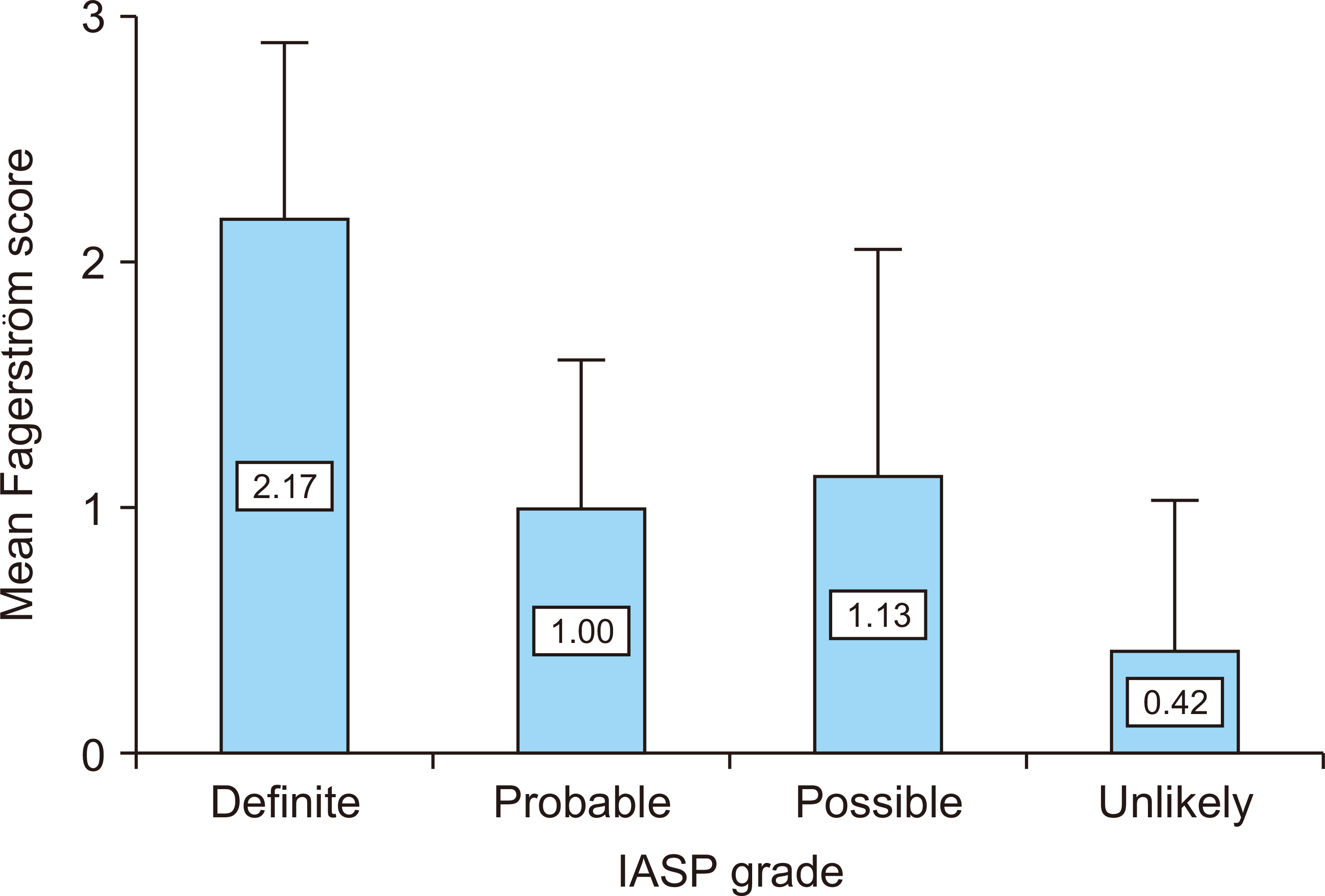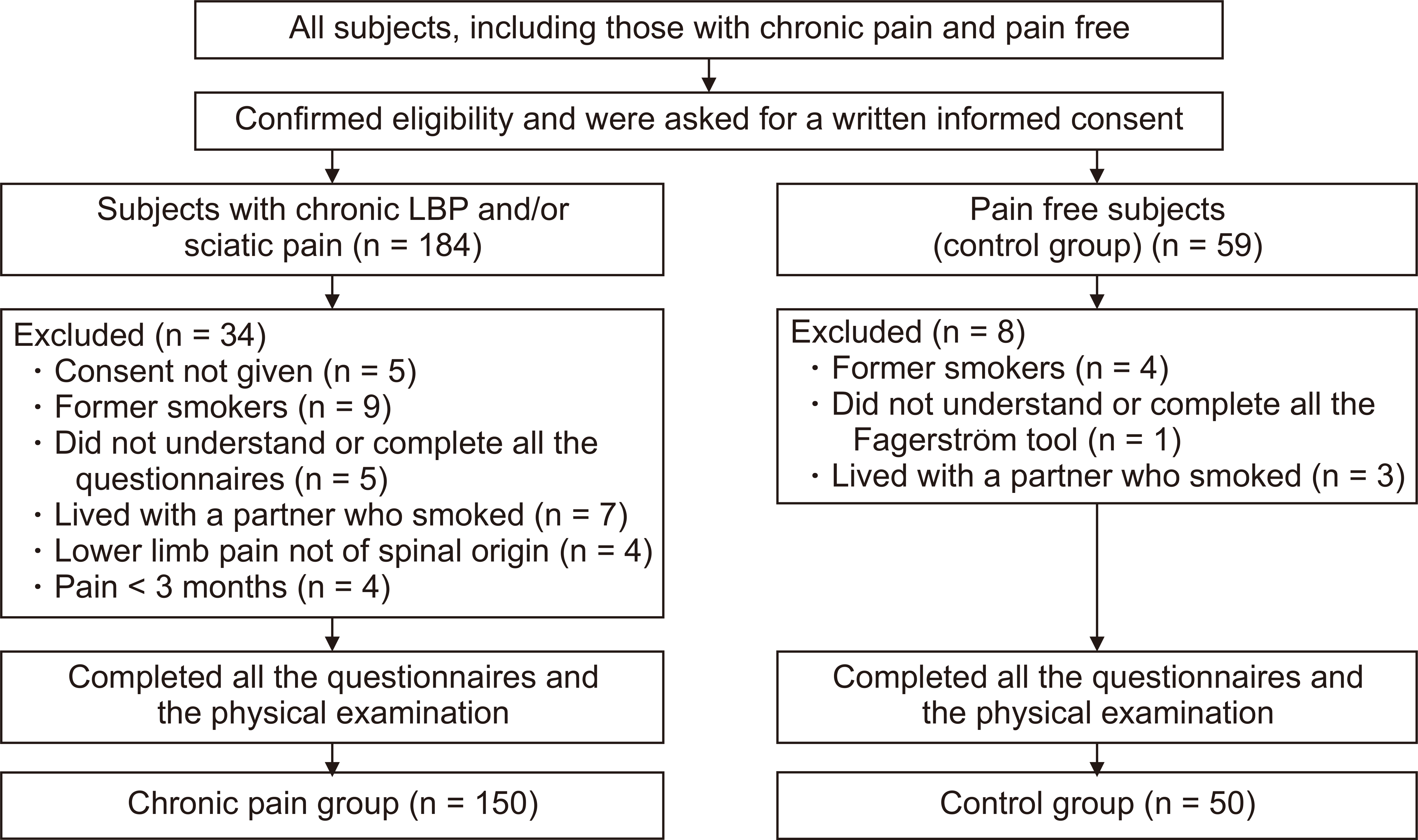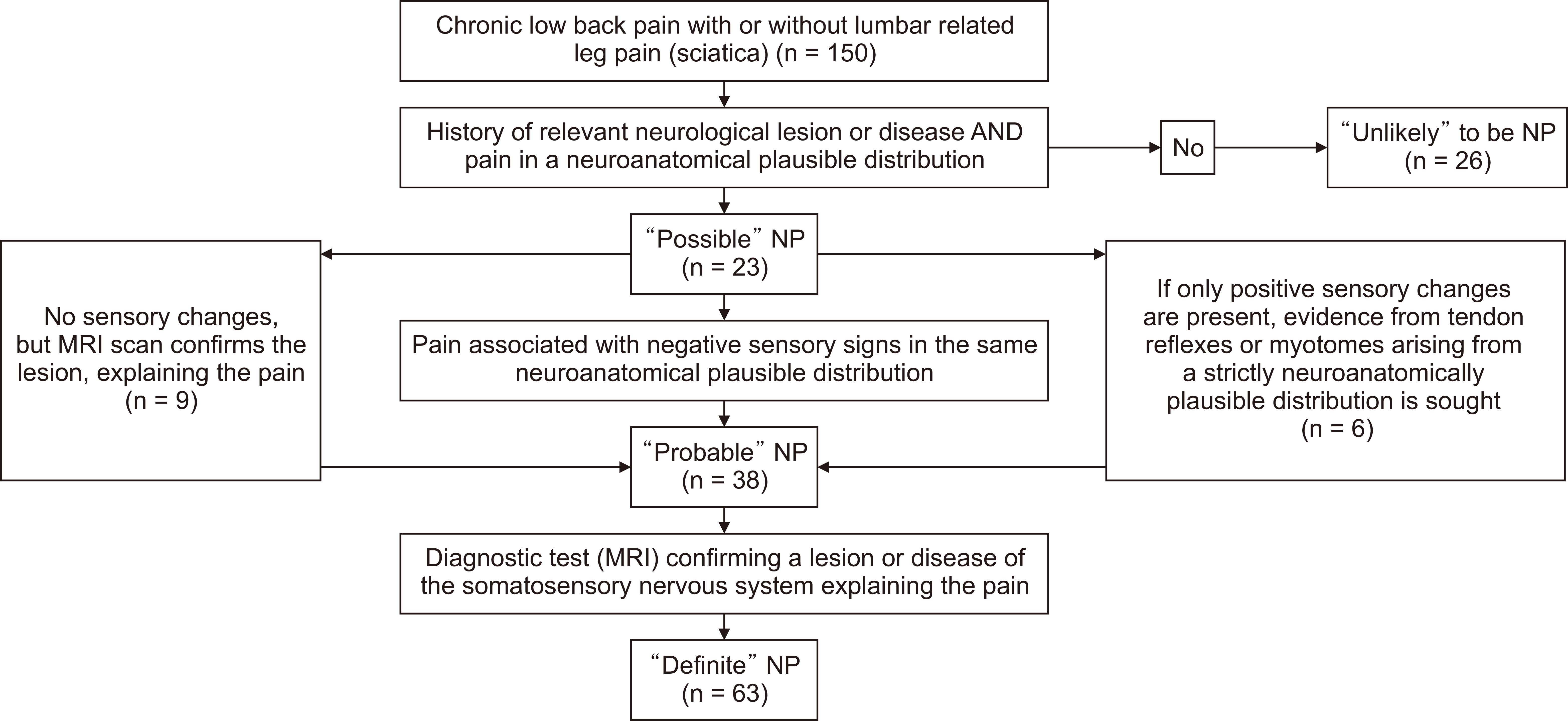1. GBD 2017 Disease and Injury Incidence and Prevalence Collaborators. 2018; Global, regional, and national incidence, prevalence, and years lived with disability for 354 diseases and injuries for 195 countries and territories, 1990-2017: a systematic analysis for the Global Burden of Disease Study 2017. Lancet. 392:1789–858. DOI:
10.1016/S0140-6736(18)32279-7. PMID:
30496104. PMCID:
PMC6227754.
2. Krismer M, van Tulder M. 2007; Strategies for prevention and management of musculoskeletal conditions. Low back pain (non-specific). Best Pract Res Clin Rheumatol. 21:77–91. DOI:
10.1016/j.berh.2006.08.004. PMID:
17350545. PMCID:
PMC6097436.
3. Colloca L, Ludman T, Bouhassira D, Baron R, Dickenson AH, Yarnitsky D, et al. 2017; Neuropathic pain. Nat Rev Dis Primers. 3:17002. DOI:
10.1038/nrdp.2017.2. PMID:
28205574.

4. Jensen TS, Baron R, Haanpää M, Kalso E, Loeser JD, Rice AS, et al. 2011; A new definition of neuropathic pain. Pain. 152:2204–5. DOI:
10.1016/j.pain.2011.06.017. PMID:
21764514.

6. Euro U, Knekt P, Rissanen H, Aromaa A, Karppinen J, Heliövaara M. 2018; Risk factors for sciatica leading to hospitalization. Eur Spine J. 27:1501–8. DOI:
10.1007/s00586-017-5182-8. PMID:
28612193. PMCID:
PMC6484005.

7. Schembri E. 2019; Are opioids effective in relieving neuropathic pain? SN Compr Clin Med. 1:30–46. DOI:
10.1007/s42399-018-0009-4.

8. Ferreira PH, Beckenkamp P, Maher CG, Hopper JL, Ferreira ML. 2013; Nature or nurture in low back pain? Results of a systematic review of studies based on twin samples. Eur J Pain. 17:957–71. DOI:
10.1002/j.1532-2149.2012.00277.x. PMID:
23335362.

9. Parreira P, Maher CG, Steffens D, Hancock MJ, Ferreira ML. 2018; Risk factors for low back pain and sciatica: an umbrella review. Spine J. 18:1715–21. DOI:
10.1016/j.spinee.2018.05.018. PMID:
29792997.

10. Cook CE, Taylor J, Wright A, Milosavljevic S, Goode A, Whitford M. 2014; Risk factors for first time incidence sciatica: a systematic review. Physiother Res Int. 19:65–78. DOI:
10.1002/pri.1572. PMID:
24327326.

11. Frost P, Johnsen B, Fuglsang-Frederiksen A, Svendsen SW. 2013; Lifestyle risk factors for ulnar neuropathy and ulnar neuropathy-like symptoms. Muscle Nerve. 48:507–15. DOI:
10.1002/mus.23820. PMID:
23424094.

12. Pourmemari MH, Viikari-Juntura E, Shiri R. 2014; Smoking and carpal tunnel syndrome: a meta-analysis. Muscle Nerve. 49:345–50. DOI:
10.1002/mus.23922. PMID:
23761223. PMCID:
PMC7494374.

13. Clair C, Cohen MJ, Eichler F, Selby KJ, Rigotti NA. 2015; The effect of cigarette smoking on diabetic peripheral neuropathy: a systematic review and meta-analysis. J Gen Intern Med. 30:1193–203. DOI:
10.1007/s11606-015-3354-y. PMID:
25947882. PMCID:
PMC4510210.

14. Suzuki T, Iwamoto T, Ochi K, Mito K, Nakamura T, Suzuki K, et al. 2016; Cigarette smoking is associated with cubital tunnel syndrome. Muscle Nerve. 54:1136–8. DOI:
10.1002/mus.25389. PMID:
27571367.

15. Khan JS, Hah JM, Mackey SC. 2019; Effects of smoking on patients with chronic pain: a propensity-weighted analysis on the Collaborative Health Outcomes Information Registry. Pain. 160:2374–9. DOI:
10.1097/j.pain.0000000000001631. PMID:
31149975. PMCID:
PMC6768701.

16. Çelik SB, Can H, Sözmen MK, Şengezer T, Kaplan YC, Utlu G, et al. 2017; Evaluation of the neuropathic pain in the smokers. Agri. 29:122–6. DOI:
10.5505/agri.2017.68815. PMID:
29039152.
17. Finnerup NB, Haroutounian S, Kamerman P, Baron R, Bennett DL, Bouhassira D, et al. 2016; Neuropathic pain: an updated grading system for research and clinical practice. Pain. 157:1599–606. DOI:
10.1097/j.pain.0000000000000492. PMID:
27115670. PMCID:
PMC4949003.

18. Markman JD, Kress BT, Frazer M, Hanson R, Kogan V, Huang JH. 2015; Screening for neuropathic characteristics in failed back surgery syndromes: challenges for guiding treatment. Pain Med. 16:520–30. DOI:
10.1111/pme.12612. PMID:
25530081.

19. Attal N, Perrot S, Fermanian J, Bouhassira D. 2011; The neuropathic components of chronic low back pain: a prospective multicenter study using the DN4 Questionnaire. J Pain. 12:1080–7. DOI:
10.1016/j.jpain.2011.05.006. PMID:
21783428.

21. Vandenbroucke JP, von Elm E, Altman DG, Gøtzsche PC, Mulrow CD, Pocock SJ, et al. 2014; Strengthening the Reporting of Observational Studies in Epidemiology (STROBE): explanation and elaboration. Int J Surg. 12:1500–24. DOI:
10.1016/j.ijsu.2014.07.014. PMID:
25046751. PMCID:
PMC6858139.

22. Dworkin RH, Turk DC, Farrar JT, Haythornthwaite JA, Jensen MP, Katz NP, et al. 2005; Core outcome measures for chronic pain clinical trials: IMMPACT recommendations. Pain. 113:9–19. DOI:
10.1016/j.pain.2004.09.012. PMID:
15621359. PMCID:
PMC7425408.

23. Hasvik E, Haugen AJ, Gjerstad J, Grøvle L. 2018; Assessing neuropathic pain in patients with low back-related leg pain: comparing the painDETECT Questionnaire with the 2016 NeuPSIG grading system. Eur J Pain. 22:1160–9. DOI:
10.1002/ejp.1204. PMID:
29436056.

24. Furman MB, Johnson SC. 2019; Induced lumbosacral radicular symptom referral patterns: a descriptive study. Spine J. 19:163–70. DOI:
10.1016/j.spinee.2018.05.029. PMID:
29800710.

25. Tampin B, Broe RE, Seow LL, George SG, Tan J, Menon R, et al. 2019; Field testing of the revised neuropathic pain grading system in a cohort of patients with neck and upper limb pain. Scand J Pain. 19:523–32. DOI:
10.1515/sjpain-2018-0348. PMID:
30901318.

26. Heatherton TF, Kozlowski LT, Frecker RC, Fagerström KO. 1991; The Fagerström Test for Nicotine Dependence: a revision of the Fagerström Tolerance Questionnaire. Br J Addict. 86:1119–27. DOI:
10.1111/j.1360-0443.1991.tb01879.x. PMID:
1932883.
27. Hill JC, Dunn KM, Lewis M, Mullis R, Main CJ, Foster NE, et al. 2008; A primary care back pain screening tool: identifying patient subgroups for initial treatment. Arthritis Rheum. 59:632–41. DOI:
10.1002/art.23563. PMID:
18438893. PMCID:
PMC7276483.

28. Beneciuk JM, Robinson ME, George SZ. 2015; Subgrouping for patients with low back pain: a multidimensional approach incorporating cluster analysis and the STarT Back Screening Tool. J Pain. 16:19–30. DOI:
10.1016/j.jpain.2014.10.004. PMID:
25451622. PMCID:
PMC4274220.

29. Toh I, Chong HC, Suet-Ching Liaw J, Pua YH. 2017; Evaluation of the STarT Back Screening Tool for prediction of low back pain intensity in an outpatient physical therapy Setting. J Orthop Sports Phys Ther. 47:261–7. DOI:
10.2519/jospt.2017.7284. PMID:
28257616.

30. Pagé I, Abboud J, O Shaughnessy J, Laurencelle L, Descarreaux M. 2015; Chronic low back pain clinical outcomes present higher associations with the STarT Back Screening Tool than with physiologic measures: a 12-month cohort study. BMC Musculoskelet Disord. 16:201. DOI:
10.1186/s12891-015-0669-0. PMID:
26286385. PMCID:
PMC4541753.

31. Beneciuk JM, Bishop MD, Fritz JM, Robinson ME, Asal NR, Nisenzon AN, et al. 2013; The STarT back screening tool and individual psychological measures: evaluation of prognostic capabilities for low back pain clinical outcomes in outpatient physical therapy settings. Phys Ther. 93:321–33. DOI:
10.2522/ptj.20120207. PMID:
23125279. PMCID:
PMC3588106.

33. Orhurhu VJ, Pittelkow TP, Hooten WM. 2015; Prevalence of smoking in adults with chronic pain. Tob Induc Dis. 13:17. DOI:
10.1186/s12971-015-0042-y. PMID:
26185492.

34. Goesling J, Brummett CM, Hassett AL. 2012; Cigarette smoking and pain: depressive symptoms mediate smoking-related pain symptoms. Pain. 153:1749–54. DOI:
10.1016/j.pain.2012.05.014. PMID:
22703693.

35. Patterson AL, Gritzner S, Resnick MP, Dobscha SK, Turk DC, Morasco BJ. 2012; Smoking cigarettes as a coping strategy for chronic pain is associated with greater pain intensity and poorer pain-related function. J Pain. 13:285–92. DOI:
10.1016/j.jpain.2011.11.008. PMID:
22325299. PMCID:
PMC3293999.

36. Michna E, Ross EL, Hynes WL, Nedeljkovic SS, Soumekh S, Janfaza D, et al. 2004; Predicting aberrant drug behavior in patients treated for chronic pain: importance of abuse history. J Pain Symptom Manage. 28:250–8. DOI:
10.1016/j.jpainsymman.2004.04.007. PMID:
15336337.

38. Shaw WS, Means-Christensen AJ, Slater MA, Webster JS, Patterson TL, Grant I, et al. 2010; Psychiatric disorders and risk of transition to chronicity in men with first onset low back pain. Pain Med. 11:1391–400. DOI:
10.1111/j.1526-4637.2010.00934.x. PMID:
20735749.

39. Zvolensky MJ, McMillan K, Gonzalez A, Asmundson GJ. 2009; Chronic pain and cigarette smoking and nicotine dependence among a representative sample of adults. Nicotine Tob Res. 11:1407–14. DOI:
10.1093/ntr/ntp153. PMID:
19828432. PMCID:
PMC2784489.

40. Shiri R, Karppinen J, Leino-Arjas P, Solovieva S, Varonen H, Kalso E, et al. 2007; Cardiovascular and lifestyle risk factors in lumbar radicular pain or clinically defined sciatica: a systematic review. Eur Spine J. 16:2043–54. DOI:
10.1007/s00586-007-0362-6. PMID:
17525856. PMCID:
PMC2140143.

41. Shiri R, Karppinen J, Leino-Arjas P, Solovieva S, Viikari-Juntura E. 2010; The association between smoking and low back pain: a meta-analysis. Am J Med. 123:87.e7–35. DOI:
10.1016/j.amjmed.2009.05.028. PMID:
20102998.

43. Green BN, Johnson CD, Haldeman S, Griffith E, Clay MB, Kane EJ, et al. 2018; A scoping review of biopsychosocial risk factors and co-morbidities for common spinal disorders. PLoS One. 13:e0197987. DOI:
10.1371/journal.pone.0197987. PMID:
29856783. PMCID:
PMC5983449.

44. Manninen P, Riihimäk H, Heliövaara M. 1995; Incidence and risk factors of low-back pain in middle-aged farmers. Occup Med (Lond). 45:141–6. DOI:
10.1093/occmed/45.3.141. PMID:
7605976.

45. Rivinoja AE, Paananen MV, Taimela SP, Solovieva S, Okuloff A, Zitting P, et al. 2011; Sports, smoking, and overweight during adolescence as predictors of sciatica in adulthood: a 28-year follow-up study of a birth cohort. Am J Epidemiol. 173:890–7. DOI:
10.1093/aje/kwq459. PMID:
21393341.






 PDF
PDF Citation
Citation Print
Print





 XML Download
XML Download